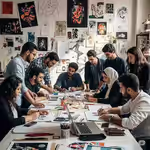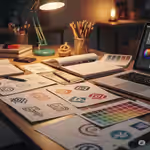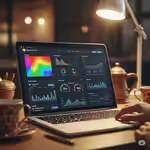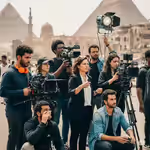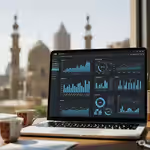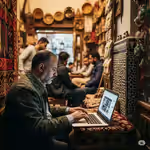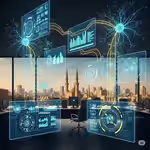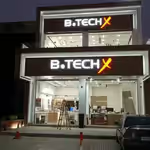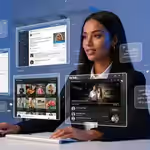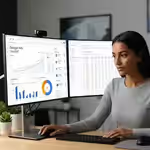Brief Introduction
Cladding is a modern facade cladding system based on composite aluminum panels, giving your facade a contemporary look with high durability, easily integrated with illuminated letters and commercial printing for a complete facade that highlights your brand in the streets of Cairo and Giza.
If you're looking for storefront cladding renovation or professional illuminated sign design or outdoor commercial printing suited to the Egyptian market, you'll find everything you need here: technical specifications, comparisons, execution steps, and local price indicators to make an informed and profitable decision for your business.
First: Cladding Facades (Composite Aluminum Panels)
Why Choose Cladding?
- Modern Appearance and Color Stability for long periods.
- Lightweight and faster installation compared to heavy claddings.
- Weather Resistance and easy cleaning and maintenance.
- Design Flexibility (cutting, bending, CNC) with integration possibilities with glass and illuminated letters.
- Safety Options with fire-resistant levels (FR) suitable for commercial activities.
Recommended Specifications as a Baseline
- Panel Thickness: 4 mm.
- Aluminum Layer Thickness (Face): ~0.5 mm.
- Fire Rating: FR B1 minimum for commercial activities, and A2 for sensitive uses.
- Exterior Paints: PVDF or Nano-PVDF for color stability and dirt resistance.
Quick Comparison Between the Most Popular Options
| Item | PVDF | Nano-PVDF |
|---|---|---|
| Outdoor Color Stability | High | Very High |
| Dirt Resistance | Good | Excellent |
| Estimated Cost | $$ | $$$ |
Installation Systems (and When to Choose Each)
- Cassette (Tray/Cassette): Bent edges and hidden fixing for a clean look without visible screws — ideal for high-end facades.
- Exposed Fixing: Economical and quick — suitable for large areas and limited budgets.
- Clip-in / Hanging Systems: Easier disassembly and maintenance in complex designs and high elevations.
Types of Paints in Brief
- PVDF: High resistance to UV rays and harsh weather.
- Nano-PVDF: Smoother surface, higher dirt resistance, easier cleaning.
Quick Checklist Before Purchase
- Verify FR Rating (B1/A2) in the Datasheet.
- Review Actual Aluminum Layer Thickness on the face.
- Request a Color Sample from the same batch before purchase.
- Document Warranty Terms (color stability/peeling/execution).
Second: Most Popular Cladding Brands and Country of Origin (Most Searched)
Important Note: The brand name alone is not enough. Always verify the Datasheet, Fire Rating Certificate, Actual Aluminum Thickness, Paint Type, and Warranty.
1) ALPOLIC (Mitsubishi Chemical) — Japan/USA/Germany
Consistent quality and strong FR options, suitable for high-end projects prioritizing safety and color stability.
2) ALUCOBOND (3A Composites) — Switzerland/Germany/USA
One of the oldest names in ACM with a wide range of finishes and colors, known for color stability and multiple FR options.
3) ALUBOND U.S.A (Mulk Holdings) — UAE and Multiple Manufacturing Bases
Widespread in the Middle East with competitive pricing, offering diverse FR categories depending on the version.
4) Gulf Bond / Saudi Bond (Common Names for Gulf/Saudi Products)
- Common local examples: GulfBond, Dalcobond (Al-Dahyan). Often provide good specifications for commercial projects at a reasonable price.
- Technobond / Techno Bond: Strong presence in Egypt and Saudi Arabia with quality certifications and good color availability.
5) Eurobond — India
Economical option with long-standing presence in the Asian ACP market and diversity in colors and thicknesses.
How to Compare Brands?
Look at: FR Rating (B1/A2), Actual Aluminum Thickness, Paint System (PVDF/Nano-PVDF), Color Availability and Spare Parts, Warranty Duration, and Local Distributor Reputation.
Pricing Factors (and Why Prices Are Not Fixed)
- Material Type and Brand (Imported/Gulf/Local) + FR Rating.
- Panel Thickness and Aluminum Layer + Paint System.
- Project Area (Quantity usually reduces price per meter).
- Design Complexity (Angles/CNC Cutting/Logo Details).
- Site Height and need for scaffolding/cranes.
- Integration of Materials and Add-ons (Glass/Stone/Illuminated Letters/Electrical Works).
Approximate Price Indicators (Variable)
Presented as "between – and between" ranges due to market and exchange rate dependency, with final quotation after inspection:
- Panels Only: Approximately between 600 – 1000 EGP/m² depending on category.
- Supply + Manufacturing + Installation: For medium projects usually between 1300 – 1700 EGP/m² as a general indicator.
- Additional Items: Metal chassis, electrical works, glass integration… priced separately or within the offer.
Expected Execution Time
- A medium facade project (≈ 300–500 m²) typically takes 4 – 6 weeks from contract to delivery (supply, manufacturing, installation, handover).
All prices are approximate and updated based on market conditions, with final price fixed in contract and detailed quotation after technical inspection and actual area measurements and proposed materials review.
Third: Illuminated Letters (Prominent Signs)
Common Types and When to Choose Each
- Illuminated Acrylic Letters (Face-Lit): Front-facing bright lighting and vibrant colors — suitable for restaurants, pharmacies, and retail stores.
- Stainless Letters with Backlighting (Backlit/Halo): Durable metal face and elegant light halo — suitable for banks, clinics, hotels, and luxury brands.
- Composite Letters (Face + Sides): Acrylic face with metal sides for depth and 3D shape.
- Flexible LED Neon (Neon Flex): Modern decorative touches for logos or internal/external frames.
Quick Quality Criteria
- LED with high efficiency and original power supplies, protection level IP65–IP66 for exposed areas.
- Acrylic/Metal Thickness suitable for letter size and height.
- Safe Wiring and protection for connections from rain and dust, with lighting test before delivery.
- Maintenance: Simple periodic cleaning extends life and maintains uniform brightness.
- Pricing: Often per centimeter height or linear meter, with complex logos as independent units.
What is the difference between Face-Lit and Backlit in terms of night visibility?
Face-Lit provides direct front brightness, while Backlit creates a subtle halo around the letter; your choice depends on brand identity and location.
How to choose the appropriate color temperature (Kelvin)?
Luxury brands tend towards 3000–4000K (warm/neutral), while bright stores use 5000–6500K (cool white).
Fourth: Commercial Printing (Outdoor/Indoor)
What Do We Use and When?
- Flex/Mesh: Outdoor banners, mesh allows air passage in large facades.
- Vinyl Sticker: For glass and walls (transparent/opaque/One-Way Vision).
- UV / Latex / Eco-Solvent: Technology chosen based on installation location to maintain color and resistance.
- Roll-Up / Pop-Up / POS: For exhibitions and in-store.
What Determines the Cost?
- Size, Material Type, Print Resolution, Finishing (grommets, cutting, reinforcement), and Quantity.
- Pricing presented as flexible ranges "between – between" and finalized after specifications review.
How canvas media eg Works (From Inspection to Delivery)
- Accurate On-Site Inspection and measurements + execution visualization (Shop Drawings).
- Material Recommendations (panel type/rating/paint + letter and lighting type + printing materials).
- Detailed Quotation for each item with clear price ranges «between – between».
- Professional Workshop Manufacturing (cutting/bending/CNC/paints) then safe and quick installation with equipment suited to your site height.
- Final Tests and Handover with Warranty + concise maintenance guidelines.
Also check our related services: Website Design and SEO and Google Ads and Social Media Management.
Our Coverage in Cairo and Giza (Local)
We serve most major and sub-areas, including: Fifth Settlement, New Cairo, Nasr City, Heliopolis, Downtown, Maadi, Helwan, Sheikh Zayed, 6th of October, Haram, Faisal, Dokki, Mohandessin, Zamalek, Agouza, Bulaq, Warraq, Ahram Gardens, Sheikh Zayed/New Zayed, and wide parts of axes and main roads.
Frequently Asked Questions (People Also Ask)
What is cladding?
Composite aluminum panels consisting of two aluminum layers with a core (PE or FR) in between, used for modern and durable facade cladding.
Do I need FR (B1/A2) for my shop?
If the activity is commercial with an exposed facade or in a high-rise building, choosing FR B1 at minimum is the safe and compliant option with many authorities.
PVDF or Nano-PVDF?
Both are suitable for outdoors; Nano-PVDF provides a smoother surface and higher dirt resistance, while PVDF is a strong standard option.
3mm or 4mm?
4mm is the most used for durable external facades. Thinner panels may be used for decorative or internal parts.
How are illuminated letters priced?
Usually per centimeter (letter height) or linear meter for frames, with price varying by face/sides material, LED type, power supplies, and installation difficulty.
Is the electricity consumption of illuminated letters high?
Consumption is relatively low thanks to modern LED technologies, varying by letter size, LED density, and operating hours.
What is the lifespan of illuminated letters?
Depends on component quality and operating conditions. With good LED and periodic maintenance, the sign retains good brightness for years.
How do I clean a cladding facade?
Warm water and gentle non-abrasive cleaner, avoiding harsh materials. Periodic cleaning is preferred to keep the facade shiny.
Can cladding be integrated with glass and letters?
Yes, and it's common to create visually cohesive facades combining durability, lighting, and transparency.
How long does it take to complete an average facade?
Usually 4 – 6 weeks from contract to delivery, may increase or decrease depending on quantity, design complexity, and material availability.
Difference between "Gulf Bond/Saudi" and global brands?
Differences in specifications, certifications, aluminum layer thickness, paint systems, and warranty. Review Datasheet and FR Certificate and compare on technical bases, not just the name.
How do I ensure quality execution?
Deal with a team with documented experience, detailed quotation, clear timeline, pre-delivery tests, and written warranty on material and work.
Is cladding suitable for coastal areas with high humidity?
Yes, provided outdoor PVDF/Nano-PVDF paints are chosen and periodic maintenance and sea salt cleaning are followed.
Can cladding panels be repainted later?
Technically possible with professional painting processes, but replacing panels is preferred to ensure color uniformity and warranty.
Quick Executive Summary
- Cladding: 4mm panel, ~0.5mm aluminum face, FR B1 minimum, PVDF/Nano-PVDF.
- Illuminated Letters: Choose type based on your brand identity (Face-Lit/Backlit/Neon Flex) with high-quality LED and suitable IP protection.
- Printing: Specify material and technology based on indoor/outdoor to ensure color stability.
- Prices: Flexible ranges determined after inspection (panels only, or turnkey delivery).
- Location: We serve all areas of Cairo and Giza through canvas media eg from inspection to delivery with warranty.
Pricing Alert: All figures are presented as approximate ranges "between – between" and change based on market, exchange rate, site nature, and design. Final quotation issued after technical inspection.







